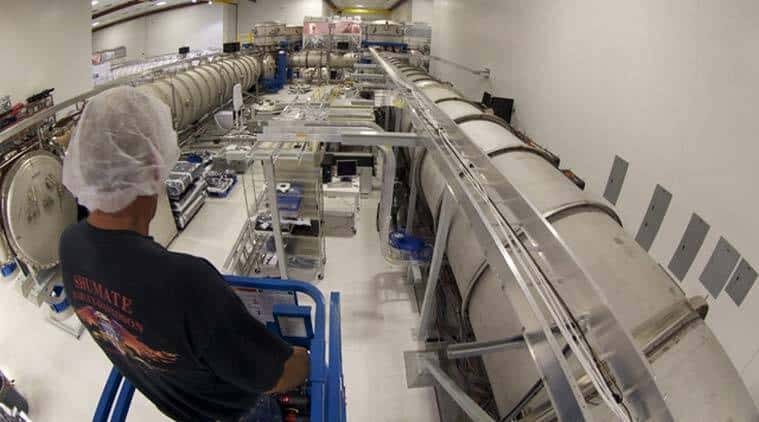What’s in today’s article?
- Why in News?
- What are the Gravitational Waves?
- What is LIGO (Laser Interferometer Gravitational-Wave Observatory)?
- What is LIGO – India?
- Why is a Fifth LIGO Observatory Needed?
Why in News?
- Seven years after an in-principle approval, the government’s final go-ahead to the LIGO project paves the way for construction of India’s largest scientific facility to probe the universe through the detection of gravitational waves.
What are the Gravitational Waves?
- These are the ripples in space-time produced by the movement of large celestial bodies like stars and planets.
- These were postulated over 100 years ago in Albert Einstein’s General Theory of Relativity that encapsulates the current understanding of how gravitation works.
- However, they were first discovered in 2015 by two LIGOs (Laser Interferometer Gravitational-Wave Observatories) based in the United States.
- In 2017, this experimental verification of the century-old theory received the Nobel Prize in Physics (to Rainer Weiss, Barry C. Barish and Kip S. Thorne).
- Until now, at least 10 events producing gravitational waves have been detected.
What is LIGO (Laser Interferometer Gravitational-Wave Observatory)?
- It is an international network of laboratories meant to detect gravitational waves.
- Under this, two large observatories (~ 3000 Km apart) were built in the US (Hanford Site, Washington and Livingston, Louisiana) with the aim of detecting gravitational waves by laser interferometry.
- Interferometry is a technique which uses the interference of superimposed waves to extract information.
- Besides the US, such gravitational wave observatories are currently operational in Europe and Japan.
- LIGO-India will be the fifth, and possibly the final node of the planned network.
What is LIGO – India?
- It is a planned advanced gravitational-wave observatory (as part of the worldwide network), which received the Indian Government’s in-principle approval in 2016.
- The LIGO detector in India would be similar to the two that are located in the US and (like these) would have two perpendicularly-placed 4-km long vacuum chambers, that constitute the most sensitive interferometers in the world.
- It will be built by the Department of Atomic Energy (DAE), Department of Science and Technology (DST), Government of India, with a MoU with the National Science Foundation (NSF), USA, etc.
- LIGO-India is a multidisciplinary mega-science project that requires expertise from a variety of fields (laser, vacuum, optics, computer, etc.) and provides cutting edge research opportunities – giving a global role to India.
- To be located in Hingoli district of Maharashtra, LIGO-India is scheduled to begin its scientific runs from 2030.
- It has taken several years for the final approval, with a budget of Rs 2,600 crore.
- It will be a unique platform that brings together in India the frontiers of science and technology of the quantum and the cosmos.
Why is a Fifth LIGO Observatory Needed?
- Extremely low strength of gravitational waves makes their detection very difficult.
- Therefore, LIGO-India is part of the plan to expand the network of gravitational wave observatories in order to increase the chances of detecting these waves from anywhere in the observable universe.
- This will improve the accuracy and quality of information taken from them.
Q1) What is the significance of detecting gravitational waves?
Detecting and analysing the information carried by gravitational waves is allowing us to observe the Universe in a way never before possible, providing astronomers and other scientists with their first glimpses of literally un-seeable wonders.
Q2) What is Albert Einstein’s General Theory of Relativity?
Einstein’s 1915 general theory of relativity holds that what we perceive as the force of gravity arises from the curvature of space and time. The scientist proposed that objects such as the sun and the Earth change this geometry.
Source: Budget is cleared to set up India’s biggest facility to probe the universe | LIGO.caltech.edu
Last updated on January, 2026
→ Check out the latest UPSC Syllabus 2026 here.
→ Join Vajiram & Ravi’s Interview Guidance Programme for expert help to crack your final UPSC stage.
→ UPSC Mains Result 2025 is now out.
→ UPSC Notification 2026 is scheduled to be released on January 14, 2026.
→ UPSC Calendar 2026 has been released.
→ UPSC Prelims 2026 will be conducted on 24th May, 2026 & UPSC Mains 2026 will be conducted on 21st August 2026.
→ The UPSC Selection Process is of 3 stages-Prelims, Mains and Interview.
→ Prepare effectively with Vajiram & Ravi’s UPSC Prelims Test Series 2026 featuring full-length mock tests, detailed solutions, and performance analysis.
→ Enroll in Vajiram & Ravi’s UPSC Mains Test Series 2026 for structured answer writing practice, expert evaluation, and exam-oriented feedback.
→ Join Vajiram & Ravi’s Best UPSC Mentorship Program for personalized guidance, strategy planning, and one-to-one support from experienced mentors.
→ UPSC Result 2024 is released with latest UPSC Marksheet 2024. Check Now!
→ UPSC Toppers List 2024 is released now. Shakti Dubey is UPSC AIR 1 2024 Topper.
→ Also check Best UPSC Coaching in India

















